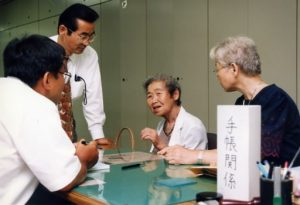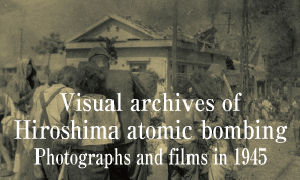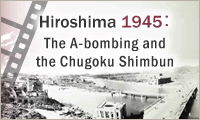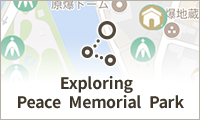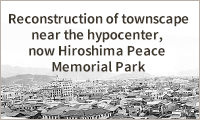Unaware those entering Hiroshima after A-bombing eligible for Survivor’s Certificate, Hisae Ishii applies 52 years later amid Sarugaku-cho restoration
Aug. 5, 1997
Moving to Fukuoka after war, she hopes “to leave record of experience”
On August 4, 1997, a woman who operated a photography studio in front of the A-bomb Dome until August 6, 1945, visited Hiroshima City Hall with her son to apply for Atomic Bomb Survivor’s Certificates. Although she had returned to what remained of her home at the hypocenter around one week after the atomic bomb was dropped, she had never realized that such certificates were also issued to those who entered the city after the bombing. “I want to leave a clear record of our experiences in the atomic bombing for my children and obtain the certificates.” That is her wish in the summer 52 years after the bombing.
Hisae Ishii, 88, who lives in Maebaru City, Fukuoka Prefecture, and her third son, Mamoru Ishii, 53, a company employee living in Hiroshima’s Asaminami Ward, visited the Hiroshima City Atomic Bomb Survivors Relief Department with Matsue Hiyama, 76, a resident of Fukuoka City’s Nishi Ward and Ms. Ishii’s cousin who served as a witness in the application process.
The Ishii family’s residence of record was 7 Sarugaku-cho, on the north side of the A-bomb Dome in what is now Peace Memorial Park, with the present-day address of Ote-machi 1-chome, in Hiroshima City’s Naka Ward. Ms. Ishii and her husband, Isao, who died 32 years ago, operated a photo studio there. In the spring of 1945, Ms. Ishii had evacuated to the town of Yoshida-cho, in the Takata-gun district, Hiroshima Prefecture, with her second son, Soji, now 56, and Mamoru. As it happens, her husband had spent the night before the bombing in Yoshida-cho. “My husband quickly returned to Hiroshima by truck on the day of the atomic bombing, and I brought the children back on August 14 or 15,” said Ms. Ishii.
She still remembers a passerby saying, “There used to be a photo studio around here somewhere.” The following year, the couple reopened their photo studio in the area of Tokaichi-machi, in the city’s Naka Ward. After her husband’s death, she moved to Fukuoka with her second son and the others, because the Hiyamas, who had resided at 20-1 Sarugaku-cho, were living there.
“My husband had a Survivor’s Certificate, but I thought only those who had returned to the city immediately after the bombing were eligible, so my two sons and I never applied.” Now that Sōji is paralyzed on the right side of his body, Ms. Ishii decided to apply for the certificate for her sons and herself on their visit to Hiroshima to attend a memorial service, held for the first time in 52 years, for former residents of Sarugaku-cho.
Ms. Hiyama experienced the atomic bombing in Hiroshima’s Nishi Ward. She said, “Mr. and Mrs. Ishii entered Sarugaku-cho looking for us, and that night, we were able to confirm each other’s well-being in Asakita Ward, where my husband and I had evacuated. Without a doubt, I am certain they stayed there with us.”
(Originally published on August 5, 1997)

